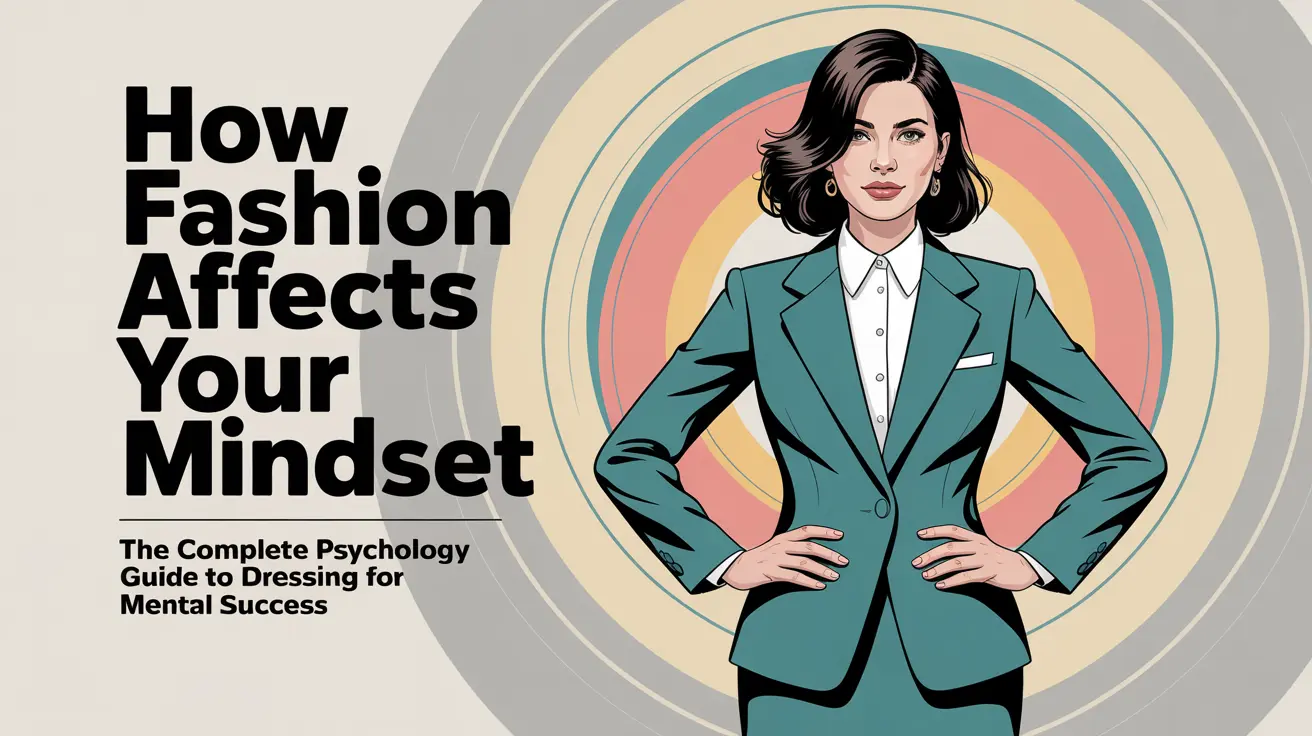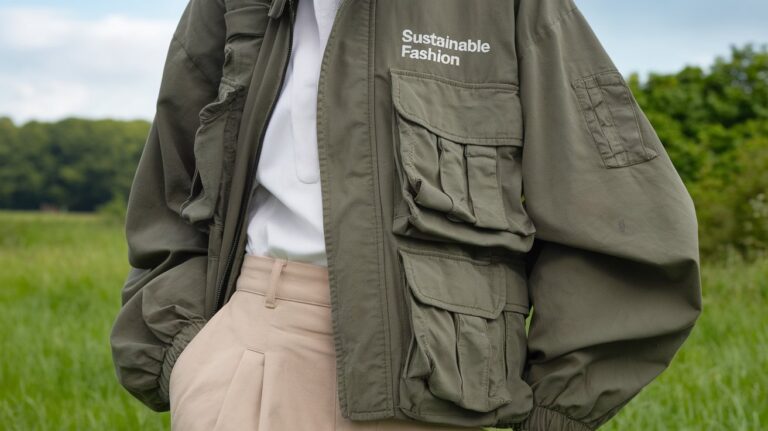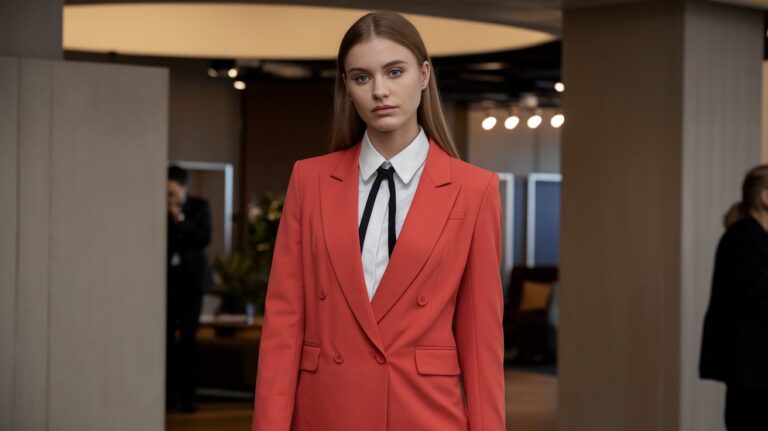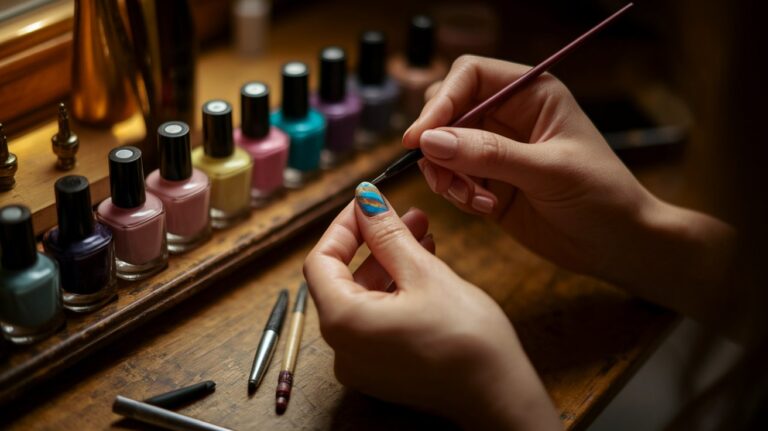How Fashion Affects Your Mindset: The Complete Psychology Guide to Dressing for Mental Success
Have you ever noticed how putting on your favorite outfit instantly makes you feel more confident? Or how wearing professional attire before an important meeting shifts your entire mental state? You’re not imagining it – there’s genuine science behind how fashion affects your mindset, and understanding this connection can transform both your wardrobe and your life.
The relationship between what we wear and how we think runs deeper than surface-level vanity. Research in fashion psychology reveals that our clothing choices create measurable changes in brain activity, hormone levels, and cognitive performance.
This phenomenon, known as enclothed cognition, demonstrates that fashion isn’t just about looking good – it’s about thinking, feeling, and performing better.
The Science Behind Fashion Psychology: Understanding Enclothed Cognition
What Is Enclothed Cognition?
Enclothed cognition, a term coined by researchers Hajo Adam and Adam Galinsky, describes the systematic influence clothing has on our psychological processes. In their groundbreaking study, participants wearing lab coats performed better on cognitive tests when told it was a doctor’s coat versus a painter’s coat. This reveals that the symbolic meaning we attach to clothing directly impacts our mental capabilities.
The mechanism works through three key psychological pathways:
- Symbolic Meaning: The cultural and personal associations we have with specific garments
- Physical Experience: How the clothing feels on our body and affects our posture
- Social Feedback: How others respond to our appearance and how we internalize that feedback
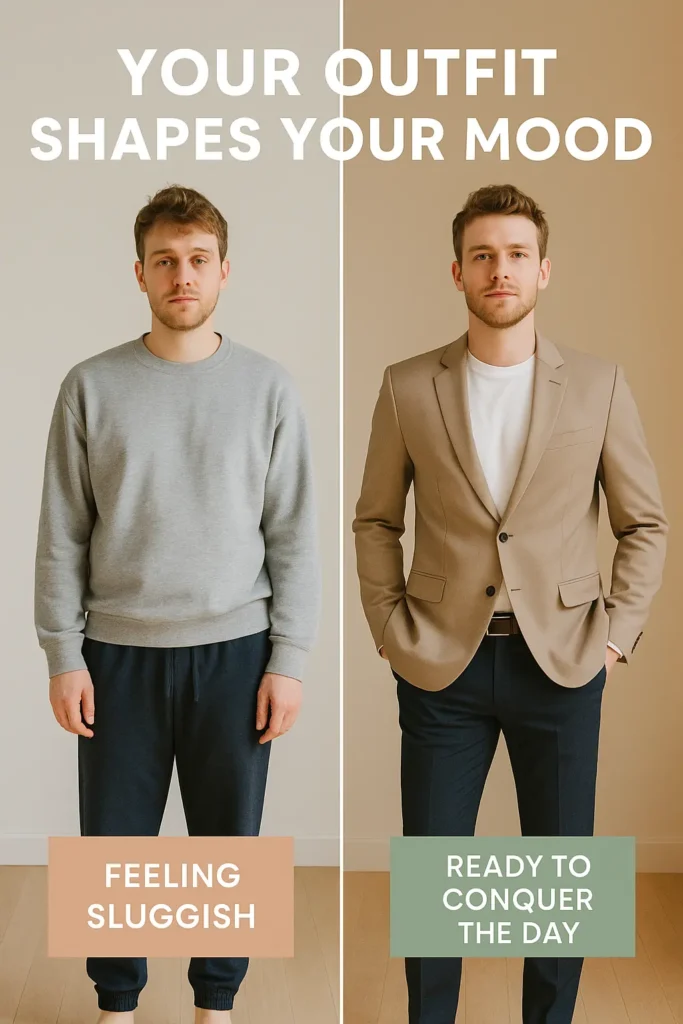
The Neurological Impact of Fashion Choices
Recent neuroscience research shows that clothing choices activate specific brain regions associated with:
- Self-concept and identity (medial prefrontal cortex)
- Social cognition and perception (superior temporal sulcus)
- Emotional regulation (anterior cingulate cortex)
- Executive function and decision-making (dorsolateral prefrontal cortex)
When you wear clothing that aligns with your desired identity or role, these brain areas become more active, literally rewiring your thought patterns to match your appearance.
How Different Types of Clothing Affect Your Mental State
Power Dressing: The Psychology of Professional Attire
The Suit Effect: Studies show that men wearing suits in business negotiations won over $2 million in simulated deals, while those in sweatpants lost $1.2 million. This dramatic difference stems from how formal attire:
- Increases testosterone levels (linked to dominance and confidence)
- Enhances abstract thinking abilities
- Improves negotiation skills
- Boosts perceived competence by others
Key Benefits of Power Dressing:
- Enhanced leadership presence
- Improved decision-making under pressure
- Greater respect from colleagues and clients
- Increased salary negotiation success
| Clothing Type | Psychological Effect | Best Used For |
|---|---|---|
| Tailored Suits | Increased dominance, abstract thinking | Business meetings, negotiations, presentations |
| Structured Blazers | Enhanced authority, professionalism | Client interactions, leadership roles |
| Quality Dress Shirts | Attention to detail, competence | Daily office wear, important calls |
| Professional Footwear | Grounding, stability | All professional settings |
Casual Wear: Fostering Creativity and Social Connection
While power dressing excels in competitive environments, casual clothing serves different psychological purposes:
Creative Enhancement: Casual and relaxed dress codes help people become more friendly and creative. Comfortable clothing reduces cognitive load, allowing more mental resources for innovative thinking.
Social Bonding: Casual attire makes us appear more approachable and relatable, facilitating:
- Better team collaboration
- More open communication
- Reduced hierarchical barriers
- Enhanced brainstorming sessions
Athletic Wear: Activating the Exercise Mindset
The Activewear Effect: Wearing gym clothes makes it more likely that we will actually exercise. This occurs through several mechanisms:
- Visual reminders of health goals
- Reduced friction in starting workouts
- Identity activation as someone who exercises
- Increased body awareness and movement
Pro Tip: Keep workout clothes visible in your bedroom or office to trigger spontaneous physical activity throughout the day.
Color Psychology: How Hues Influence Your Mood
Colors create distinct psychological responses that can be strategically leveraged:
High-Energy Colors:
- Red: Increases energy, assertiveness, and confidence
- Orange: Enhances enthusiasm and creativity
- Yellow: Boosts optimism and mental clarity
Calming Colors:
- Blue: Promotes stability, trust, and clear communication
- Green: Reduces stress and enhances focus
- Purple: Encourages introspection and luxury feelings
Professional Colors:
- Navy: Conveys authority and reliability
- Charcoal: Projects sophistication and seriousness
- White: Suggests cleanliness and new beginnings
The Hidden Psychology of Undergarments
One of the most surprising discoveries in fashion psychology is how undergarments affect our mindset. Even our underwear affects the way we feel about ourselves, with wearing something perceived as sexy making us feel more self-assured, powerful, and confident.
This “foundation confidence” works because:
- It creates a psychological armor of self-assurance
- Nobody else knows, making it purely internal validation
- Quality undergarments improve posture and comfort
- It reinforces positive self-talk throughout the day
Strategy: Invest in high-quality undergarments that make you feel confident, even if no one else will see them.
Practical Strategies for Using Fashion to Improve Your Mindset
1. The Mood-Boosting Wardrobe Audit
Create clothing categories based on psychological needs:
Confidence Builders:
- Well-fitted blazers
- Favorite jeans
- Statement accessories
- Quality footwear
Stress Relievers:
- Soft, comfortable fabrics
- Loose-fitting clothes
- Neutral, calming colors
- Familiar, worn-in pieces
Energy Enhancers:
- Bright colors
- Structured silhouettes
- Bold patterns
- Athletic-inspired pieces
2. The Strategic Dressing Technique
Before important events, ask yourself:
- What mindset do I need to cultivate?
- How do I want others to perceive me?
- What would someone successful in this situation wear?
- How can my clothing support my goals?
Then dress accordingly, paying attention to:
- Fit: Ensure clothes neither restrict movement nor appear sloppy
- Color: Choose hues that align with your desired emotional state
- Style: Select pieces that reflect your aspirational identity
- Comfort: Prioritize clothing that won’t distract from your performance
3. The Uniform Strategy for Decision Fatigue
Many successful individuals adopt personal “uniforms” to:
- Reduce daily decision fatigue
- Create consistent psychological priming
- Establish a recognizable personal brand
- Streamline morning routines
Consider developing uniforms for:
- Work days: Professional, confidence-building outfit formula
- Creative projects: Comfortable, inspiring clothing combination
- Social events: Go-to ensemble that makes you feel attractive and sociable
- Exercise: Motivating athletic wear that encourages movement
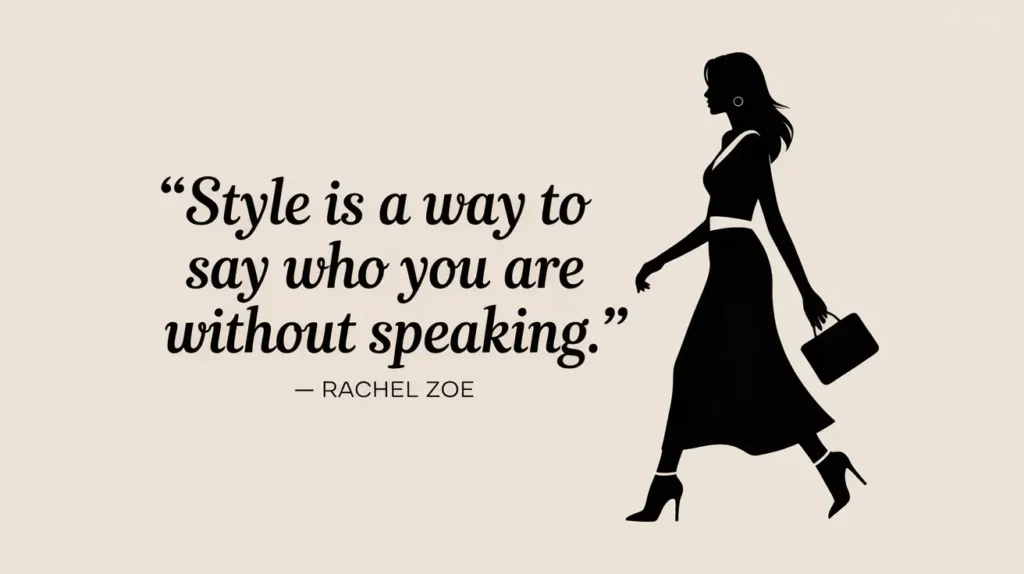
Fashion’s Impact on Mental Health and Well-being
Therapeutic Dressing for Depression and Anxiety
Fashion can serve as a tool for managing mental health challenges:
For Depression:
- Wear brightly colored clothes as they work as a mini pick-me-up, boosting mood and energy
- Choose textures that feel pleasant against the skin
- Prioritize comfortable fits that don’t restrict movement
- Include at least one item that holds positive memories
For Anxiety:
- Select calming colors like soft blues or greens
- Choose familiar, well-loved pieces for comfort
- Avoid tight or restrictive clothing that might increase physical discomfort
- Include grounding elements like weighted accessories or textured fabrics
Building Self-Esteem Through Fashion Choices
The Empowerment Approach:
- Identify your best features and choose clothing that highlights them
- Invest in quality basics that fit perfectly and feel luxurious
- Express your personality through unique accessories or style elements
- Practice positive self-talk when getting dressed each morning
The Role Model Technique: Research shows that when we emulate the dress code of people we consider smart and powerful, we feel infused with these qualities as well. This doesn’t mean copying someone’s exact style, but rather:
- Identifying admirable qualities in others’ fashion choices
- Adapting those elements to fit your personality and lifestyle
- Using clothing to embody characteristics you want to develop
- Gradually building confidence through stylistic experimentation
Cultural and Social Aspects of Fashion Psychology
Fashion as Identity Expression
Clothing serves as a non-verbal communication system that conveys:
- Cultural background and heritage
- Social status and economic position
- Personal values and beliefs
- Professional identity and competence
- Creative expression and individuality
Understanding these signals helps you:
- Make intentional choices about the messages you send
- Navigate different social and professional contexts appropriately
- Build authentic personal style that reflects your true self
- Respect cultural norms while expressing individuality
The Social Feedback Loop
The psychology of fashion creates a continuous cycle:
- You choose clothing based on desired identity or mood
- Others respond to your appearance with specific behaviors
- You internalize this feedback, reinforcing or adjusting your self-concept
- Your confidence and behavior shift based on these interactions
- Future clothing choices are influenced by these experiences
Being aware of this loop allows you to:
- Break negative cycles by making empowering fashion choices
- Leverage positive feedback to build confidence
- Adjust your style based on your goals and environment
- Maintain authenticity while adapting to social expectations
Advanced Fashion Psychology Techniques
The Occasion-Based Dressing Matrix
Different situations require different psychological states. Use this matrix to optimize your clothing choices:
| Situation | Required Mindset | Clothing Strategy | Key Elements |
|---|---|---|---|
| Job Interview | Competent, Trustworthy | Conservative Professional | Navy suit, minimal accessories |
| Creative Meeting | Innovative, Approachable | Smart Casual | Unique details, comfortable fit |
| Networking Event | Confident, Memorable | Polished with Personality | Statement piece, quality basics |
| Presentation | Authoritative, Clear | Power Dressing | Structured silhouettes, bold colors |
| Date | Attractive, Authentic | Personal Style Emphasis | Flattering fit, favorite pieces |
The Psychological Wardrobe Investment Strategy
Instead of buying clothes randomly, invest strategically in pieces that serve specific psychological functions:
Priority 1: Confidence Foundations
- One perfectly fitted suit or dress
- High-quality undergarments
- Comfortable, stylish everyday shoes
- Classic accessories (watch, jewelry, bags)
Priority 2: Mood Enhancers
- Bright, cheerful pieces for difficult days
- Comfort items for stress relief
- Statement pieces for special occasions
- Versatile basics in flattering colors
Priority 3: Professional Tools
- Industry-appropriate clothing
- Networking-optimized outfits
- Presentation-worthy ensembles
- Travel-friendly professional wear
Measuring the Impact: How to Track Fashion’s Effect on Your Mindset
Daily Mood and Outfit Tracking
For one month, record:
- Morning outfit choice and reasoning
- Mood rating (1-10) before and after getting dressed
- Confidence level throughout the day
- Compliments or reactions received
- Overall day satisfaction rating
This data will reveal patterns between your clothing choices and psychological states.
The Confidence Experiment
Try these controlled experiments to observe fashion’s impact:
Week 1: Wear only your absolute favorite, most confidence-boosting outfits Week 2: Dress in comfortable but unremarkable clothing Week 3: Experiment with bolder colors and styles than usual Week 4: Focus on perfect fit and high-quality fabrics
Compare your energy levels, productivity, social interactions, and overall satisfaction across these weeks.
Overcoming Common Fashion Psychology Challenges
“I Don’t Have Time to Think About Clothes”
Solution: The Sunday Prep Strategy
- Spend 30 minutes each Sunday planning the week’s outfits
- Consider your schedule and choose clothes that support each day’s goals
- Prepare everything the night before to reduce morning decisions
- Create a photo album of successful outfit combinations for quick reference
“I Can’t Afford a Psychology-Based Wardrobe”
Solution: The Strategic Upgrade Approach
- Start with one key piece that makes you feel incredible
- Focus on fit over brand names – tailoring inexpensive clothes often beats expensive ill-fitting garments
- Invest in versatile basics that work across multiple situations
- Shop your own closet first – you may already own powerful pieces you’ve forgotten about
“I Don’t Know What Looks Good on Me”
Solution: The Discovery Process
- Take photos of yourself in different outfits and note which ones make you feel best
- Ask trusted friends for honest feedback about your most successful looks
- Consider consulting with a personal shopper or image consultant
- Experiment with different styles in low-risk situations
The Future of Fashion Psychology
Emerging Research Areas
Scientists are exploring:
- Smart textiles that respond to stress levels and adjust accordingly
- Virtual reality fashion experiences for psychological therapy
- Sustainable fashion and its impact on environmental anxiety
- Gender-neutral clothing and its effects on self-expression
- Cultural fashion therapy for immigrant communities
Technology Integration
Future applications might include:
- Apps that recommend outfits based on your schedule and emotional needs
- Smart mirrors that provide psychological feedback on clothing choices
- Biometric clothing that adapts to your physiological state
- AI stylists trained in psychology principles
Conclusion: Transforming Your Life Through Intentional Dressing
Fashion affects your mindset in profound and measurable ways. By understanding the science of enclothed cognition and applying strategic dressing techniques, you can:
- Boost confidence before important events
- Enhance creativity during brainstorming sessions
- Improve professional performance in competitive situations
- Support mental health during challenging periods
- Express authentic identity while achieving social goals
The key is moving from unconscious clothing choices to intentional wardrobe decisions that align with your psychological needs and life objectives. Your closet isn’t just storage for fabric – it’s a toolkit for mental transformation.
Start small: tomorrow morning, before getting dressed, ask yourself, “How do I want to feel today, and what can I wear to support that feeling?” Then observe the difference. You might be surprised by how much power lies in that simple shift from reactive to strategic dressing.
Remember, the best-dressed person isn’t necessarily wearing the most expensive clothes – they’re wearing the clothes that make them feel most authentically and powerfully themselves. That’s the true art of fashion psychology, and it’s available to everyone willing to pay attention to the profound connection between what we wear and who we become.

